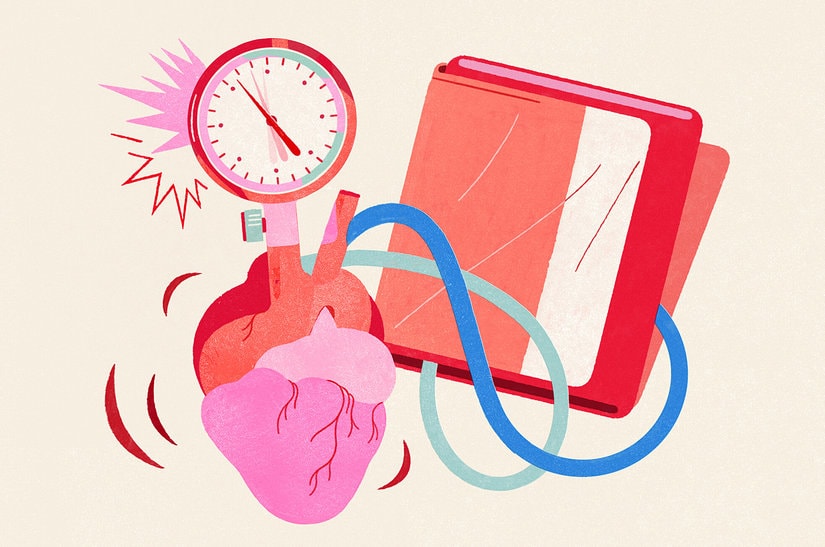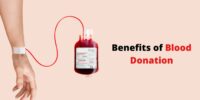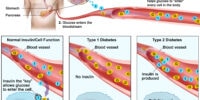The Link Between Blood Pressure And Cardiovascular Health

Cardiovascular disease is a leading cause of death worldwide, and high blood pressure is a major risk factor for this condition. Blood pressure is the force of blood against the walls of arteries, and it is measured using two numbers: systolic pressure (the top number) and diastolic pressure (the bottom number).
High blood pressure, also called hypertension, occurs when these numbers are consistently elevated above normal levels. The link between blood pressure and cardiovascular health is well established, with numerous studies demonstrating that high blood pressure significantly increases the risk of heart attack, stroke, and other cardiovascular events.
Understanding the risks of high blood pressure and how to manage it is crucial for preventing and treating cardiovascular disease. This article will explore the link between blood pressure and cardiovascular health, the risks of high blood pressure, lifestyle changes and medications for managing blood pressure, the role of exercise in cardiovascular health, and how to monitor blood pressure levels for optimal health.
Key Takeaways
- High blood pressure is a major risk factor for cardiovascular disease, contributing to up to 50% of all CVD cases.
- Lifestyle changes, such as maintaining a healthy diet and engaging in regular physical activity, can help manage blood pressure levels.
- Regular monitoring of blood pressure levels is important, both in clinical settings and at home using a reliable blood pressure monitor.
- Preventative measures and lifestyle modifications should be implemented early on to reduce the risk of developing cardiovascular disease.
What is High Blood Pressure?
High blood pressure, also known as hypertension, is a medical condition characterized by persistent elevated levels of blood pressure that can lead to serious cardiovascular complications. Blood pressure is the force exerted by the blood against the walls of the blood vessels, and it is measured in millimeters of mercury (mmHg).
A normal blood pressure reading is typically considered to be below 120/80 mmHg, while a reading of 140/90 mmHg or higher is classified as hypertension.
High blood pressure can occur due to a variety of factors, including genetics, lifestyle choices, and underlying medical conditions. It is often referred to as a ‘silent killer’because it may not cause noticeable symptoms until it has already caused damage to the cardiovascular system.
If left untreated, hypertension can increase the risk of heart attack, stroke, heart failure, and other serious health complications. Therefore, it is important to monitor blood pressure regularly and take steps to manage it if it becomes elevated.
Understanding Cardiovascular Disease
Cardiovascular disease is a multifactorial condition that affects the heart and blood vessels, resulting in impaired cardiovascular function.
It includes a range of conditions such as coronary artery disease, stroke, heart failure, and peripheral artery disease.
These conditions can be caused by various factors including high blood pressure, high cholesterol, smoking, obesity, lack of physical activity, and genetics.
There are several ways to prevent or manage cardiovascular disease. Firstly, a healthy diet and regular exercise can help reduce the risk of developing cardiovascular disease.
Secondly, managing blood pressure, cholesterol, and blood sugar levels is crucial in preventing cardiovascular disease.
Finally, avoiding smoking and reducing alcohol intake can also lower the risk of developing cardiovascular disease.
By following these guidelines, individuals can reduce their risk of developing cardiovascular disease and maintain better cardiovascular health.
The Risks of High Blood Pressure
Elevated levels of arterial force can significantly increase the likelihood of adverse health outcomes. One of the most common adverse health outcomes associated with elevated blood pressure is cardiovascular disease (CVD). CVD is a group of disorders that affect the heart and blood vessels, including conditions such as coronary artery disease, stroke, and heart failure. High blood pressure is a major risk factor for CVD, and it has been estimated that up to 50% of all CVD cases are attributable to high blood pressure.
The table below highlights some key risks associated with high blood pressure:
| Risk Factor | Description | Impact on Cardiovascular Health |
|---|---|---|
| Atherosclerosis | Buildup of plaque in the arteries | Increases risk of heart attack and stroke |
| Hypertensive Heart Disease | Heart damage due to high blood pressure | Increases risk of heart failure |
| Aneurysm | Weakness in the walls of blood vessels | Increases risk of rupturing and causing life-threatening bleeding |
| Kidney Disease | Damage to the kidneys due to high blood pressure | Increases risk of heart disease and stroke |
Understanding these risks is important because it underscores the importance of managing blood pressure levels. By reducing or controlling high blood pressure, individuals can significantly reduce their risk of developing CVD and other associated conditions. This can be achieved through lifestyle changes such as maintaining a healthy weight, engaging in regular physical activity, quitting smoking, and reducing salt intake, as well as through medication in some cases.
Lifestyle Changes for Managing Blood Pressure
Managing blood pressure levels through lifestyle changes is an effective way to reduce the risk of developing associated health conditions. These lifestyle changes can include adopting a healthy diet, engaging in regular physical activity, maintaining a healthy weight, limiting alcohol intake, and quitting smoking.
A healthy diet consists of consuming low-fat, low-sodium, and high-fiber foods such as fruits, vegetables, whole grains, and lean proteins. Regular physical activity can include activities such as brisk walking, cycling, swimming, or other forms of aerobic exercise for at least 30 minutes a day, most days of the week.
Maintaining a healthy weight is also essential in managing blood pressure levels. Losing weight through a combination of diet and exercise can significantly reduce blood pressure. Additionally, limiting alcohol intake and quitting smoking can also help lower blood pressure levels.
Alcohol consumption should be limited to no more than two drinks per day for men and one drink per day for women. Smoking cessation is also critical, as smoking can significantly increase blood pressure levels, which can lead to the development of cardiovascular disease.
By making these lifestyle changes, individuals can effectively manage their blood pressure levels and reduce their risk of developing associated health conditions.
Medications for High Blood Pressure
Pharmaceutical interventions are a common approach to treating hypertension. These medications work by relaxing the blood vessels, increasing the amount of urine produced, or slowing down the heart rate.
There are several classes of medications used to manage high blood pressure, including diuretics, ACE inhibitors, beta blockers, calcium channel blockers, and angiotensin receptor blockers.
While these medications can effectively lower blood pressure, they do come with potential side effects. Some common side effects of blood pressure medications include dizziness, fatigue, headaches, and sexual dysfunction.
It is important for individuals to work closely with their healthcare provider to find the right medication and dosage that works best for them. Additionally, lifestyle changes such as maintaining a healthy weight, engaging in regular exercise, and reducing sodium intake can complement medication use and further improve blood pressure control.
The Role of Exercise in Cardiovascular Health
Regular physical activity has been shown to have a significant impact on the overall well-being of individuals with hypertension, with numerous studies highlighting its ability to improve overall cardiovascular function.
Exercise can help lower blood pressure, reduce cholesterol levels, and decrease the risk of developing heart disease. It can also improve heart health by increasing the strength and efficiency of the heart muscle, improving circulation, and reducing inflammation.
The American Heart Association recommends that adults engage in at least 150 minutes of moderate-intensity aerobic exercise per week, or 75 minutes of vigorous-intensity aerobic exercise per week.
This can include activities such as brisk walking, cycling, swimming, or jogging. Resistance training, such as weightlifting, can also be beneficial in improving overall cardiovascular health.
However, it is important for individuals with hypertension to consult with their healthcare provider before starting an exercise program, as certain activities may not be suitable for everyone.
Monitoring Blood Pressure Levels
One critical aspect of maintaining optimal health is the consistent monitoring of arterial tension to detect early warning signs of potential health complications.
Blood pressure levels can vary throughout the day and across different situations, making regular monitoring an essential part of cardiovascular health management.
There are two primary methods for monitoring blood pressure levels: self-monitoring at home using a blood pressure monitor and having it measured in a clinical setting.
When monitoring blood pressure levels at home, it is important to select a reliable blood pressure monitor and follow the manufacturer’s instructions carefully.
It is also essential to take multiple readings at different times of the day and record the results for later analysis.
In a clinical setting, blood pressure measurements are usually taken using a sphygmomanometer, which consists of an inflatable cuff that is placed around the upper arm and a pressure gauge.
The healthcare professional will inflate the cuff to a level above the expected systolic pressure and then slowly release the pressure while listening for the sound of blood flow in the brachial artery.
Overall, monitoring blood pressure levels regularly is a critical aspect of maintaining optimal cardiovascular health and detecting potential health complications early on.
Preventing and Treating Cardiovascular Disease
Preventative measures and lifestyle modifications such as maintaining a healthy diet, engaging in physical activity, and avoiding smoking are crucial for reducing the risk of developing and treating cardiovascular disease.
A healthy diet that is low in salt, saturated and trans fats, and cholesterol is important for maintaining a healthy heart.
Regular physical activity can help to improve cardiovascular fitness, strengthen the heart, and reduce the risk of developing hypertension, which is a major risk factor for cardiovascular disease.
Additionally, avoiding smoking and limiting alcohol consumption can help to reduce the risk of developing cardiovascular disease.
In addition to these lifestyle modifications, there are also various medications and medical procedures that can be used to prevent and treat cardiovascular disease.
For example, medications such as statins, aspirin, and blood pressure-lowering drugs can be used to reduce the risk of developing cardiovascular disease.
In some cases, medical procedures such as angioplasty, stenting, and bypass surgery may be necessary to treat blockages in the arteries that can lead to heart attacks and other cardiovascular events.
Ultimately, the best approach to preventing and treating cardiovascular disease involves a combination of lifestyle modifications, medications, and medical procedures, tailored to the individual’s specific risk factors and medical history.
Conclusion
In conclusion, high blood pressure is a significant risk factor for cardiovascular disease and other health complications. Understanding the link between blood pressure and cardiovascular health is essential for managing and preventing these conditions.
Lifestyle changes, such as maintaining a healthy diet and exercise routine, can help manage blood pressure levels. In addition, medications may be necessary to control high blood pressure in some cases. Regular monitoring of blood pressure levels is also crucial to prevent and treat cardiovascular disease.
Overall, preventing and treating cardiovascular disease requires a comprehensive approach that includes lifestyle modifications, medications, and regular monitoring of blood pressure levels. It is important to work with healthcare professionals to develop an individualized plan to manage blood pressure and reduce the risk of cardiovascular disease.
By taking proactive steps to manage blood pressure levels, individuals can significantly improve their overall health and quality of life.









